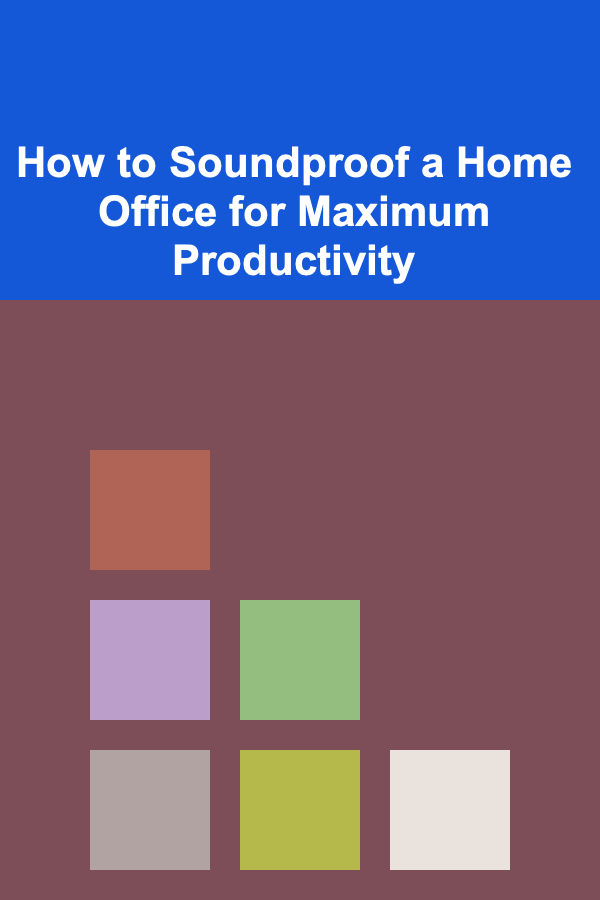
How to Soundproof a Home Office for Maximum Productivity
ebook include PDF & Audio bundle (Micro Guide)
$12.99$9.99
Limited Time Offer! Order within the next:

In the modern era, many people have transitioned to working from home. While this shift provides flexibility and comfort, it also brings a set of challenges---chief among them being noise. Whether it's the sounds of traffic outside, children playing, or the hum of household appliances, distractions can greatly diminish your productivity. Creating a quiet, peaceful home office is not only a matter of comfort but also one of efficiency.
Soundproofing a home office is essential for anyone looking to maximize their productivity. A soundproofed environment minimizes distractions, promotes focus, and helps in maintaining mental clarity throughout the day. In this detailed guide, we will explore the reasons why soundproofing your home office is important, the types of noise that affect your workspace, and step-by-step strategies and materials you can use to create the perfect soundproof home office.
Why Soundproofing Your Home Office Matters
The Impact of Noise on Productivity
Noise is more than just a nuisance; it can have serious impacts on both mental and physical well-being. Research has shown that exposure to excessive noise can lead to higher stress levels, poor concentration, and lower overall productivity. A noisy work environment often increases cognitive load, making it harder to think clearly, process information, or remain focused on tasks.
In particular, sounds that are unpredictable or irregular (such as the noise of passing cars or a dog barking) tend to be the most disruptive. The brain can struggle to filter these out, which leads to reduced focus and constant distraction. On the other hand, a quiet, controlled environment promotes concentration, creativity, and calmness---qualities essential for high-quality work.
Types of Noise in a Home Office
Before diving into soundproofing solutions, it's important to understand the types of noise that affect your workspace. Broadly, there are two categories:
- Airborne Noise: This includes sounds that travel through the air, such as conversations, music, traffic, or television. Airborne noise can pass through walls, windows, and ceilings, making it a major concern in shared living spaces.
- Impact or Structure-Borne Noise: This type of noise occurs when vibrations are transmitted through solid materials. Examples include footsteps, heavy appliances moving, or furniture being dragged across the floor. While impact noise is less common, it can still be problematic if you're in a multi-story building or if your home office is near busy areas.
The goal of soundproofing is to block or absorb both of these types of noise to create a peaceful, productive environment.
Key Strategies for Soundproofing Your Home Office
1. Seal Gaps and Cracks
One of the simplest and most cost-effective ways to reduce noise in your home office is by sealing gaps and cracks around windows, doors, and walls. Even small openings can allow sound to leak in or out, defeating the purpose of other soundproofing efforts.
How to Seal Gaps:
- Door Gaps: Install door sweeps or weatherstripping to seal the edges of doors. Gaps at the bottom of doors are especially problematic, as they let in both noise and drafts.
- Window Gaps: Use caulk or acoustic sealant around window frames to close any gaps. For larger gaps or older windows, consider using heavy curtains or acoustic window inserts.
- Wall Cracks: Fill any cracks or holes in the walls with joint compound or acoustical sealant. These small gaps, if left unsealed, can allow sound to pass through easily.
By sealing these common gaps, you'll significantly reduce the amount of noise entering your home office.
2. Use Soundproofing Materials
Once the gaps are sealed, it's time to use soundproofing materials. Several materials are specifically designed to block or absorb sound. Let's look at the best options for your home office.
A. Acoustic Foam Panels
Acoustic foam panels are one of the most popular soundproofing materials for home offices. These panels are made from open-cell foam that absorbs sound waves, reducing echoes and reverberations in a room. They're especially useful for reducing high-frequency noise, such as voices, computer sounds, or air conditioning.
- Placement: Install the foam panels on walls and the ceiling, focusing on areas where sound reflections are most likely to occur (e.g., opposite windows or hard surfaces).
- Aesthetics: Acoustic foam comes in various colors and designs, so you can choose something that matches your office décor.
B. Mass Loaded Vinyl (MLV)
Mass Loaded Vinyl (MLV) is a dense, flexible material that's designed to block sound. It works by adding mass to surfaces, which helps prevent sound from traveling through walls, floors, and ceilings. MLV is especially effective at blocking low-frequency sounds, such as bass-heavy music or rumbling traffic.
- Placement: You can install MLV on walls, under flooring, or on ceilings to enhance soundproofing. It can be particularly useful if you live in a noisy neighborhood or near a busy street.
C. Acoustic Panels and Baffles
Acoustic panels and baffles are another great option for soundproofing your office. These materials are designed to absorb sound and reduce reverberation in the room. They come in various designs, from traditional panels to modern, artistic baffles that hang from the ceiling.
- Placement: These should be installed on the walls and ceiling, especially in areas with hard surfaces, such as glass or metal.
D. Carpet and Rugs
For soundproofing floors, carpet is an excellent option. Carpet is naturally effective at reducing both airborne and impact noise. If your home office has hardwood or tile floors, adding a thick carpet or area rug can reduce the amount of noise from foot traffic or objects moving across the floor.
- Underlayment: For even better results, consider adding a soundproof underlayment beneath the carpet. This additional layer will further absorb vibrations and prevent sound from traveling through the floor.
3. Upgrade Your Windows
Windows are often the weakest link in terms of soundproofing, as they are typically made of thin glass that allows sound to pass through easily. To soundproof your home office effectively, consider upgrading your windows.
A. Double-Glazed Windows
Double-glazed windows feature two layers of glass with a gap in between, which helps insulate against both sound and temperature. These windows significantly reduce airborne noise and can be an excellent investment for long-term soundproofing.
B. Window Inserts
If replacing your windows is not an option, you can install acoustic window inserts. These are additional panes of glass or acrylic that fit inside your existing windows, further reducing sound transmission.
4. Create a Soundproof Door
Doors are another potential source of noise leakage. Standard interior doors, especially hollow-core doors, don't do much to block sound. You can enhance the soundproofing of your office door with a few simple upgrades.
How to Soundproof Your Door:
- Solid Core Door: Replace a hollow-core door with a solid-core door. Solid doors are much denser and provide better soundproofing.
- Door Seals: Add a door sweep at the bottom and weatherstripping around the edges of the door to prevent sound from leaking through gaps.
- Door Plugs: If you're in a particularly noisy environment, you can also install a temporary door plug (a removable acoustic panel that fits in the door frame) for additional sound blocking.
5. Decouple the Structure
In situations where you're dealing with severe noise from adjacent rooms, decoupling the structure of the home office can be an effective method for blocking sound.
How to Decouple:
- Resilient Channels: Install resilient channels on the walls or ceiling. These flexible strips help to decouple the drywall from the studs, reducing the direct transmission of sound vibrations.
- Acoustic Isolation Clips: These clips further isolate the drywall from the frame, creating a barrier that minimizes the transfer of sound between rooms.
6. Use Soundproofing Curtains
Soundproofing curtains are made from dense, thick fabrics designed to absorb sound and block external noise. They are an easy and effective solution for reducing noise from outside, particularly if you have windows that face a noisy street or parking lot.
How to Use Soundproof Curtains:
- Cover All Windows: Install soundproof curtains on every window in your office. Be sure to cover the entire window area, as even small gaps can let sound through.
- Multiple Layers: For maximum effectiveness, use curtains with multiple layers of sound-absorbing fabric. You can also combine soundproof curtains with other window treatments for even better noise control.
7. Create a Quiet Zone with Furniture
The placement of your furniture can also have an impact on soundproofing. Some furniture items, such as bookshelves, couches, and padded chairs, can help absorb sound and create a quieter environment. Strategically arranging your furniture can also help block sound from entering your office.
How to Optimize Furniture Placement:
- Place Heavy Furniture Against Walls: Heavier furniture can act as a barrier to sound. Place bookshelves, filing cabinets, or couches against shared walls to reduce noise transmission.
- Use Soft Furnishings: Soft fabrics, such as curtains, cushions, and upholstered furniture, can help absorb sound within the room and reduce echoes.
Conclusion
Soundproofing a home office is an essential step in creating a workspace that fosters concentration, reduces distractions, and increases productivity. By understanding the different types of noise that affect your environment and employing the strategies outlined in this guide, you can significantly improve the acoustics of your home office.
From sealing gaps and upgrading your windows to adding acoustic panels and furniture, each step will contribute to a quieter, more focused work environment. With the right soundproofing techniques, you can transform your home office into a space that promotes efficiency, creativity, and productivity, free from the disruptions of unwanted noise.

Essential Tips for Pet Care on a Budget: Keep Your Pet Happy Without Breaking the Bank
Read More
From Risk to Regulation: A Compliance Officer's Guide to Staying Ahead
Read More
How to Build a Data Analysis Checklist for Statistical Significance
Read More
How to Create a Crafting or DIY Drawer in the Kitchen
Read More
How to Ensure Your Rental Property Meets Safety Standards
Read More
How to Animate Realistic Water in Blender
Read MoreOther Products

Essential Tips for Pet Care on a Budget: Keep Your Pet Happy Without Breaking the Bank
Read More
From Risk to Regulation: A Compliance Officer's Guide to Staying Ahead
Read More
How to Build a Data Analysis Checklist for Statistical Significance
Read More
How to Create a Crafting or DIY Drawer in the Kitchen
Read More
How to Ensure Your Rental Property Meets Safety Standards
Read More